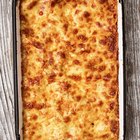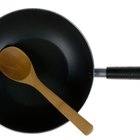
tingtoshi/iStock/Getty Images
Udon is a thick, white Japanese noodle, and its primary ingredient is wheat, making it a high-carbohydrate food. It's listed on menus at most Asian diners, and you may find its chewy texture a welcome change from traditional noodles. The noodles may also seem more filling because of their thickness and ability to soak up more of the moisture and flavor around them. The noodles are normally served cold or in a broth with vegetables or protein.
Noodle Nutrition
Both udon noodles and spaghetti pasta usually have a serving size of 2 ounces. Dry udon noodles contain about 180 to 200 calories for a 2-ounce serving. Sodium is another item that can fluctuate wildly with brands. Standard dry whole-wheat spaghetti noodles pack similar calorie amounts, ranging from 180 to 220 in similar servings. Most noodles come in packages with four to eight servings. Moderation is key when enjoying this type of noodle.
Related Articles

Difference Between Cellophane Noodles & ...

Directions on How to Cook Soba Noodles

How to Cook Penne Rigate Noodles in the ...

How to Cook Udon

How to Cook Lasagna Noodles Al Dente

How to Cook Luglug Cornstarch Noodles

How Many Calories are in Cheese Lasagna?

Calories in Bowtie Pasta

How to Fry Raw Spaghetti

Calories in Gluten Free Pasta

Can You Use Vegetable Oil Instead of ...

How to Cook Steel-Cut Oats in a Slow ...

How to Make Sweet Brown Rice

How to Dry Baseball Caps

Can I Pour Hot Water in a Baking Dish ...

Differences Between Tapioca Starch and ...

How Long After a Sell-By Date Can You ...
How to Cook Grits in the Microwave

How to Cook Lasagna Noodles so They ...

Cooking Dried Banh Pho Noodles
References
Writer Bio
Adam Scott is a nutrition-minded father and husband. Currently he is pursuing a master's in nutrition and food studies at a major East Coast University. Soon he will be a Registered Dietitian and continue teaching proper nutrition. His work has been seen in many major newspapers.
Photo Credits
tingtoshi/iStock/Getty Images